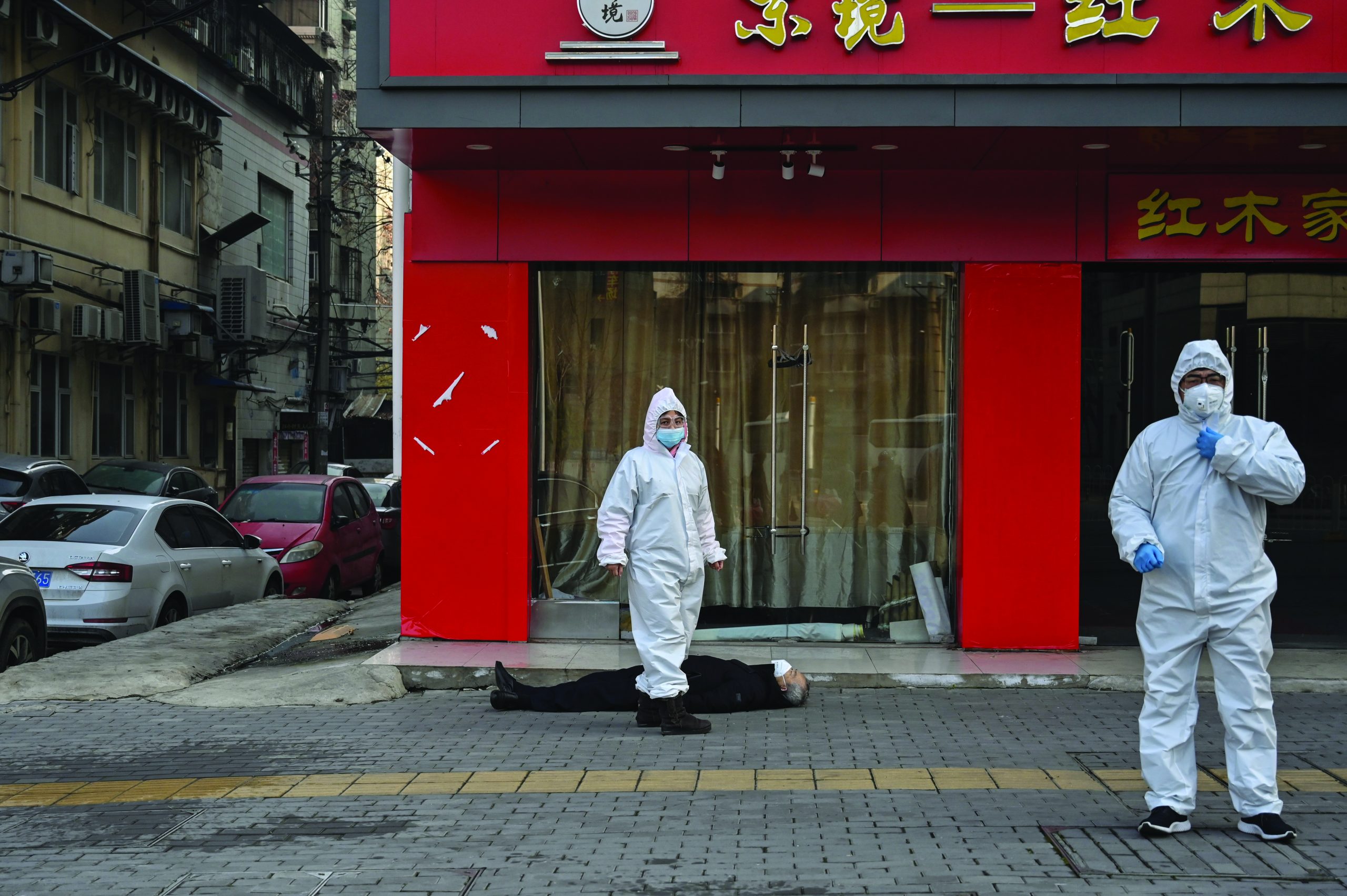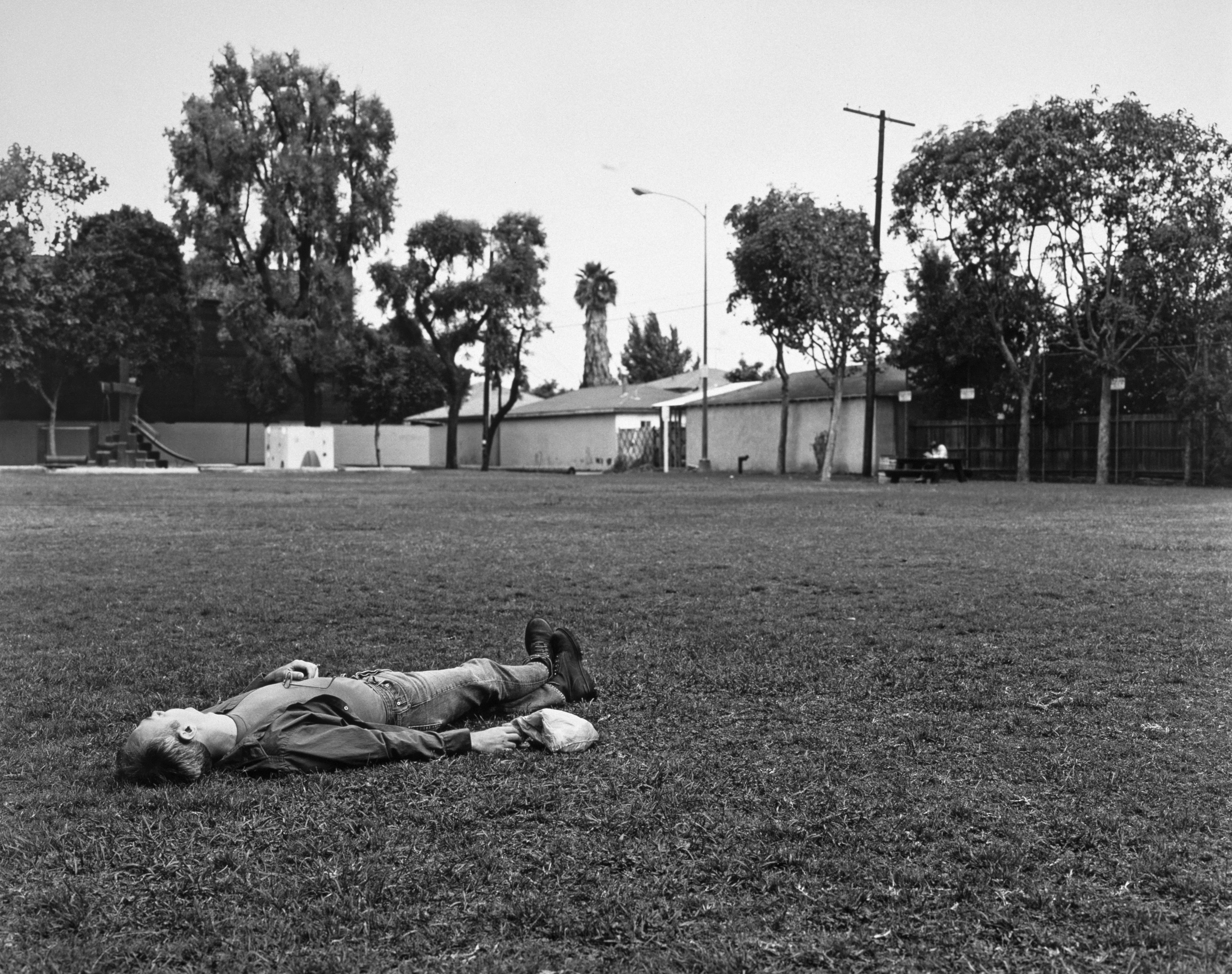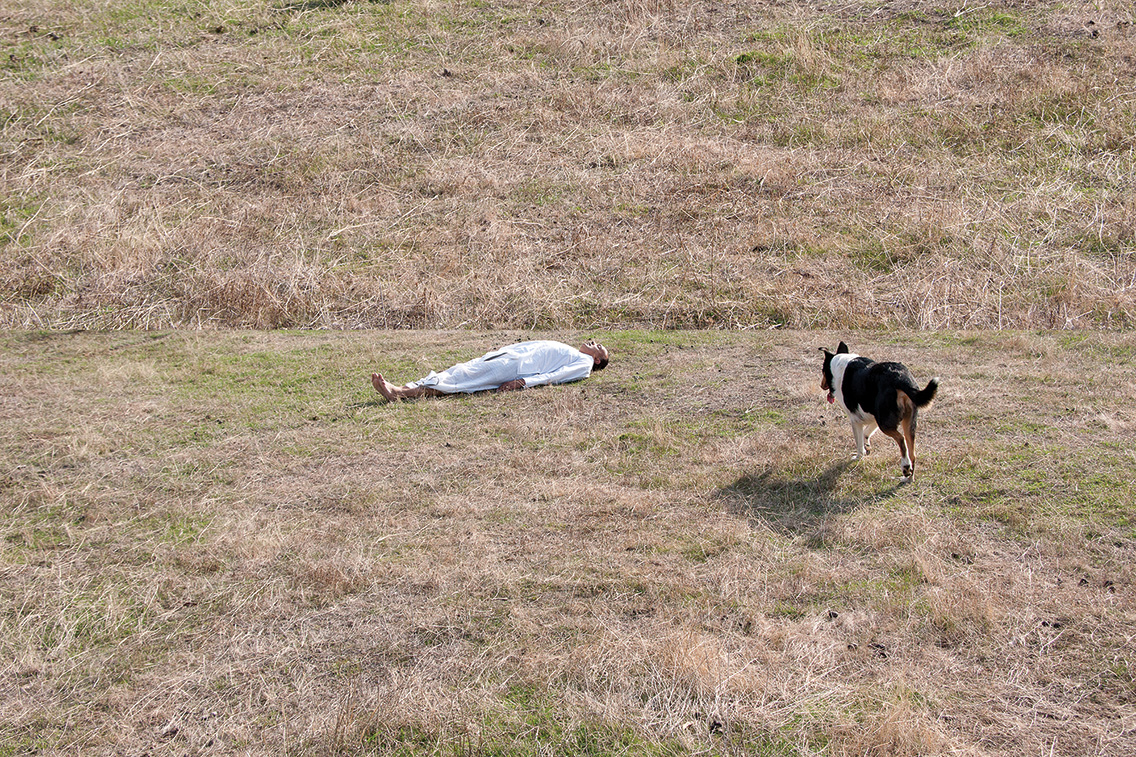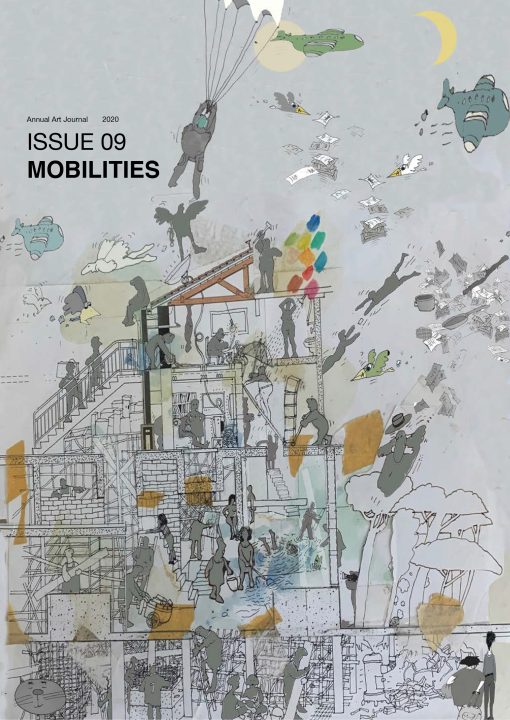[Stillness] makes one vulnerable; it draws one into the world differently and it accesses new agencies and movement. Or not. Such is the complexity of the topologies/ecologies and economies (in every sense of the word) of still.1
Down the road: Propinquity and place in a mobile world
We are a collaborative duo, calling ourselves Down the Road Projects (DtRP)—an artist and a cultural geographer who live and work on the edge of the Goldfields National Park in Central Victoria, Australia in unceded Dja Dja Warrung country. Our projects are art-based, pan-disciplinary and experiential, and revolve around issues of place, identity, belonging and becoming.
We both live in Fryerstown in Central Victoria. Quite an isolated place in many respects, it’s easy to be alone and feel isolated, to walk through the Australian bush and think that everything is happening elsewhere. Yet the mobility of ideas and their translation across media makes everything unnervingly connected and present. Being ‘in place,’ being ‘down the road,’ matter to us. We are a part and apart of the interconnectedness of the world.
Living in a state of disruption
When we began this paper COVID-19 was pretty much confined to Wuhan, China. We were shocked by images of dead bodies, crowded hospital corridors, and people being dragged into isolation. We felt immobilised in the face of the virus. Now the virus and the institutional lockdowns, travel restrictions, bans on gathering, and many closed non-essential facilities have caught up with us. Like Wuhan, and many cities and countries around the globe, we are now under emergency laws. We are immobilised in new and unexpected ways. Not only is physical movement restricted but we also find ourselves in a state of bewildered suspension. The novel virus has engendered a novel state of being, a state of interruption. New forms of stillness are becoming apparent, from state coerced immobility, to travel bans, to self-imposed isolation.
For ISSUE 09, DtRP developed a conversation (often fragmented) as part of a collaborative process reflecting on mobility. But we were immediately drawn to ideas of immobility rather than mobility, as the chronology of disasters we were living through—the democratic protests in Hong Kong, the devastating bushfires in Australia, and spreading contagion of COVID-19—each flowed into the next fluidly and without reprise. We could have put this down to the simple logistics of considering mobilities’ binary; to talk about immobility as oppositional, but it was more than that. Any easy talk about mobility and its relationship to globalisation, a discourse that has pervaded the social, cultural and economic fabric of our lives, became impossible as a new quality of stillness, haunted by death, enveloped us through these tumultuous and shifting times.
and Donna Haraway, and a discursive commentary on three images that include immobilised solitary horizontal bodies in the picture plane, as a way of unpacking mobility and stillness in a performative way. It attempts to move the discussion from the consequences of disaster events and narratives to the idea of stillness as events where the stilled body becomes the performing agent. What happens when mobility is denied or not possible? What new spaces open up, what new relations emerge, and what further insights into mobility are generated?
We live(d) in a mobile world
The ‘mobilities turn’ postulates a world in motion, a world of flux, where bodies, objects and ideas are fluid and dynamic. It celebrates the purposeful, active and upstanding, agentive subject. Mobility has transformed the world in complex and significant ways, to the extent that “social life, civil society and political participation are increasingly understood as being performed through mobilities.”2 Relations and places are no longer static, but multi-sited and performative.
Performative modes of practice and ‘being’ invariably value action. The sense of being always in motion defines contemporary existence for many, and the image of the busy, active individual travelling through airports, boarding trains, moving in a blur of networked connections, has come to represent the active subject of the mobile world. We are in perpetual motion and the interrelatedness and interdependencies of activity and outcome seems to be constantly driving us and the environments we inhabit. Yet in the time and place that we find ourselves, the characteristic notions of mobility and the mobile subject arouse in us a sense of consternation and disconcertment.
The virus is on the move. It’s crossed species, from bat to pangolin to human. It knows how to mutate, to spread, to hitch a ride to somewhere else. It’s a shapeshifter. Viruses need a host to get around, and this one, by hitching a ride with globalised humans in our much-vaunted ‘mobile world,’ has found the perfect travel partner. It’s now spreading across the globe, popping up in unsuspecting places, multiplying, disseminating itself to all corners of the world. It started with another global movement, that of the illegal wildlife trade where protected animals like the pangolin are secretly traded across regions, across borders, landing in wildlife meat markets in far flung places. Viruses and species meet in a “dance of encounters,”3 with the movement of one curtailing the movement of the other: a sort of seesaw effect of mobility and containment. Contained virus, mobile people; mobile virus, contained people. It makes you realise just how much mobility is contingent on forms of containment, whether in the form of vaccinations, borders, hospital wards, or self-isolation. Everywhere around the globe new modes of viral immobility are gripping citizens.
Fissures and cracks in the promise of global mobility:
life in the shadow of containment
An image we found particular harrowing, one that felt cinematic and unreal, was reported across a range of online news platforms with the following headline: “Lifeless Body of Man Lying on Empty Wuhan Street Witness to Chilling Reality of Coronavirus Outbreak.”4

Emergency staff in protective suits check the body of a man who collapsed and
died in the street in Wuhan on Thursday. (AFP)
This is the new image for unprecedented times: the prone body. The death posture, the dead body lying on its back is the new archetype that haunts the current situation supplanting the upright, hurrying body of the mobile world.
From both a formal and contextual position, the image is complex. As a form of documentary, it is chilling and disturbing. The text of the story describes the man as elderly, wearing a face mask and carrying a plastic shopping bag in one hand. It goes on to report that the figure was “[seen by] AFP journalists prior to an emergency vehicle arriving with police and medical staff arriving.” The report adds that the scene was only one block away from a hospital.5
The position of the body is surprising. He is not slumped over, or against a wall. His body is not contorted. The mask and the shopping bag give the sense that the prone figure was attempting to undertake everyday necessities of shopping. Or perhaps he was on his way to the hospital seeking some form of medical support. The scene is so everyday, but rendered troubling by the closed shops and empty streets. What is confronting and so remarkable about this image is the horizontality of the body in this location. How did a man on his way to or from the shops end his time in the classic funereal position of the body laid out ready for burial/cremation?
Compositionally the image appears staged (as staged as any of Jeff Wall’s photographs). The composition is defined by strong horizontal and vertical lines and forms. The strong red form of the architecture, the yellow painted horizontal line on the pavement, and most significantly the two vertical forms of the medical officers dressed in white, one intersecting the black clad horizontal figure on the ground.
What is doubly disturbing in the image is the frontal gaze of the two medical officers, as if caught in a scene that needs to be controlled and contained as much as the virus itself. They look menacingly toward the camera, which is now witness to, and documentary evidence of, an unfolding event which we know authorities want to manage in their own way.
Some forms of containment arrive with the force of disaster. The people of Wuhan know this in the form of a government lockdown and immobilisation with stringent regulation—a repressive, controlling form of containment. The people at Wuhan know what it feels like to be trapped, to be stuck, to find yourself somewhere where it’s too late to leave, when choice and mobility run out. The citizens confined to their apartments silently enduring the wait belie the tension between movement and stillness: an enforced, apprehensive suspension of waiting in uncertain conditions; a turbulent stillness of contradictory forces; of being immobile when you want to be mobile; of being trapped somewhere when you want to be somewhere else. But lines of containment are never impervious. Containment is an ideal: a dream of stability. Like the US policy of Containment in the Cold War, no protection is permanent, no barrier complete, no defence perpetual. Containment dances with stillness and mobility in dynamic tension. Such a state of contagious suspension and immobilisation usher in a new mode of globalisation, and new experiences of what it means to be a mobile global citizen.
The stilled body as citizen

Jeff Wall, Citizen, 1996
Silver gelatin print 181.2 x 234 cm
Kunstmuseum Basel
The exhausted citizen, no longer the upstanding agentic subject, now becomes the prone body stranded in public space. Artist Jeff Wall’s black and white photograph, Citizen (1996) depicts a solitary figure in repose in an unspecified park setting. In Wall’s photograph, the title tells us (presumably) that the figure in the photograph is a citizen. But a citizen of where? A world citizen? A citizen of Canada, similar to Wall? In what context does Wall use the word ‘citizen’? Should we equate citizen with the legality of citizenship, which offers a person the right to be domiciled in a country? Does the figure in the photograph have legal citizenship to be in the country in which the park is located? Or is Wall using the word to challenge the very notion of who has a right to belong to the future? Issues such as these make Wall’s photograph so interesting and compelling at this time of viral pandemic when the future is so uncertain. As Laymert Garcia dos Santos asks so pertinently: “Who has the right to belong to the future of humanity, and who is condemned to disappear?”6
The gesture of legs crossed, one arm loosely slumped on his chest, depicts the secure and relaxed body of a person at home in their surroundings, a person in place located on the vast open lawns of an urban park. The momentary and instant peace that Wall constructed in this image is now disrupted by the virus. Citizens are no longer safe and comfortable or free to roam in public spaces. The compositional device of foregrounding the solitary prone figure at the front of the picture plane using a strong diagonal, creates a heightened tension and makes us complicit and witness to ideas of citizenship itself.
Today, in the face of the virus, citizens have been called home by governments, and some left stranded when time frames shift in the urgency of response. We have become vulnerable as citizens to the regulatory powers of government and the ability of decision-makers to act strategically in unknown and unexpected situations. As citizens, our lives—or deaths— are in the hands of our country’s response to the virus. The importance of ‘home’ has become intensified as people struggle to find ways to get to their home country, and once there, find themselves confined to home space.
Mobility is a key construct of ‘the citizen,’ as the citizen is defined by holding the rights of free movement within the nation-state as well as the ability to cross borders.
Historically, the citizen has been entwined with threatening others, initially the vagrant, and more recently the alien or migrant.7
Today the coronavirus has taken the place of the ‘threatening Other’ as the spread of the virus has closed travel across borders and impeded the performance of citizenship in public spaces. The shrinking space of citizenship alters the sorts of citizen we can be, by curtailing both rights and restricting the spaces within which such rights can be performed. It provokes us to question the very notion of what it is to be a citizen in the context of the citizen’s relation to mobility.
Reading Citizen through this lens of the viral pandemic problematises the figure as it can no longer oscillate between a subject exhausted and besieged by the pandemic and one which lies in the secure knowing of arriving home and surrendering to the circumstance of immobility: immobility not to be mistaken as something lost, but an immobility of quiet resistance. Citizen and the idea of citizenship are plunged into a state of ambiguity and the citizen becomes a paradoxical geographical subject8 when mobility as a given of citizenship is now curtailed. Spaces of performing citizenship in spaces such as the public park are no longer available in a time of ‘lockdown’.
The eventful space of becoming:
The stilled body and landscape in suspension
Apart from death, immobility is never absolute, there is always something, someone on the move, shifting the dynamics; always in a situation of constant becoming. This leads some to consider immobility or stillness as an ‘event’, as a doing, not an endpoint or stasis.9 The event of stillness “breaks with the familiar the recognisable and the comfortable”10 to pull us, unwillingly perhaps, into an intensified state awash with indeterminacy.
Acknowledging that we all live somewhere, not the anywhere of mobile existence, we consider becoming stilled as a strategy to reconnect with community and place. We seek out the new agency of stillness, in Bissell’s terms of being drawn into the world differently,11 not as succour or withdrawal, but as a different way of making worlds in a generative moment of fluidity. The artwork Between Dreaming and Dying (2015) carries us into an eventful space of suspension, a state between the dreams of ‘normal life’ and the spectre of death.

Rhett D’Costa, Between Dreaming and Dying, 2015
inkjet photographic print on Hahnemühle FineArt Pearl paper 285 gsm,
97 x 66 cm (framed) Edition of 3
Between Dreaming and Dying is a framed photograph which sits against the inside edge of the frame, creating a sense of its own containment. The imagery in the photograph consists of a grass field, a single male figure in white garments lying in repose diagonally across the picture frame, and a dog that seems to be moving toward the figure. It is an ambiguous image, as its title suggests, where the figure is suspended between states of dreaming and dying. But what exactly is the connection between the acts of dreaming and dying? Perhaps both involve the physical act of lying down, both involve the process of some form of transformation from the physical realm to a form of non-physicality. Dreaming and dying, figure and field are in the process of being acted out, rather than fixed. They are performed as event.
So what is this body doing in this site, in this state of immobility? The photograph has been specifically staged. Both states, ‘dreaming’ and ‘dying’, have to accept the idea of ‘letting go,’ which is the crucial point in the image. But what is being ‘let go’ by the protagonists in the picture? Contextually, it is the idea of place as fixed. The figure lies in this suspended state in a cleared paddock in central Victoria. The bleached grass suggests a hot, dry climate. A horizon line has been created by cutting and digitally stitching two images together, suggesting a precarious precipice in the picture and rendering the landscape in the photograph as spatially disorienting. It is difficult to register depth of field and scale. Like the figure, the space in the photograph is ambiguous and indeterminate. It feels like both an actual and an imagined terrain. The body, either dreaming or dying seems besieged by the menacing dry landscape, by the heat, by the dog making its way to the body, and (possibly) by death itself, a consequence of the pandemic.
The situation is simultaneously one of rest and anxiety, which sets the conditions of the figure imagining what the future may hold. In between the state of living and dying, the figure accepts this state of suspension, where imagination of place becomes borderless and multiple. The spatially ambiguous landscape in the photograph presents, here and elsewhere, simultaneously. In this way, the figure in Between Dreaming and Dying (2015) is located in a simultaneity of place and time. Its presence articulates: “He is in the act of re-performing. He is under siege. He is in a state of hope and optimism dreaming in anticipation and is in retreat, sleeping.”12
In many ways this image entangles the idea of the figure as dead (Wuhan image) and the figure as citizen (Wall). The figure in Between Dreaming and Dying is suspended between these two states and is emblematic of the situation we find ourselves in today. We can no longer be sure if the figure will fall into the precipice in the landscape or stand vertically and become mobile. Furthermore, we can no longer be sure that the constructed landscape itself will not collapse, folding in on itself along the digitally stitched line. The constructed landscape suspends stability and puts all elements in motion. With no fixed ground, as Bissell and Fuller notes, we and the world become differently. The “promise of still is a particular mode of engagement with a world that rearranges intensities, folds through the vital and the vulnerable, providing a new set of political and ethical concerns.”13
Conclusion
Stillness brings into focus the place, situation and assemblage of human and nonhuman others that constitute the still figure. Unlike the blur of the background of the mobile subject, or the blurred scenery from the train window, the setting insists on being part of stillness/immobility. ‘Where’ matters: the paddock, the park, the street, all attend in constitutive ways to the still/ed body.
It’s only when things break down, when things go awry, and novel viruses appear, that the assumptions, standards, and values that make things appear ‘normal’; make mobility appear as ordinary and everyday, are brought into focus, and the machinations of daily life are disrupted and brought into question.
For some this suspended reality has brought an unexpected sense of being in the world where they no longer have to keep up with the manic, speedy, overstimulated world of contemporary mobile society. The requirements to work faster, go to more places, see more people, be even more busy, evaporate as travel restrictions are imposed and social distancing becomes the expected norm. For these people, the virus presents an opportunity to slow down and reflect upon the pace of consumption and the futility of contemporary life in the new economy. But, of course, such reflection is not available to workers in precarious jobs, to displaced migrants, asylum seekers and the like. They know about a different kind of immobility.
Writing this paper at this moment in time as the viral disaster continues to unfold has been in many ways an act of poiesis—something very much in process, creating its own intrinsic complexities and ironies as we attempt to navigate everyday practices, and the indeterminate spaces between stillness and mobility. The space outside the body of the COVID-19 virus is shifting, evolving and changing rapidly on an hourly and daily basis, as is official reporting, social discourse and policy, destabilising any attempts of fixity. These fluid states, which in a practical sense may lead to heightened states of anxiety, also have the potential of bringing about transformative encounters through the unfolding experiences of living with the virus. In this respect, these troubling times, when engaged through the lens of poiesis, can take on forms of quiet resistance, appearing under the guise of immobility and leading us to a state of being present and still as affirmative actions.
What sits inside the complexity of this equation is time itself. The speed of the virus, the speed of an evolving and destabilizing world as we watch the number of cases and deaths increase, world economies decrease to alarming levels and people move from mobility to stillness based on their own circumstances and situations. For DtRP this brings us back to where we started: in our neighbourhood, socially distancing down the road from each other—unsettled, confused and immobilised. The destabilisation we feel provokes a reconfiguration of identities and places—personal and spatial.
Donna Haraway urges us to “stay with the trouble”14 as a strategy to find ways of making more liveable futures. Staying with the virus and its mobility, forces a recognition of the multispecies world we live in and for us to take seriously the agency of nonhumans. It forces us to consider how global connections shape our local lives and vice versa, and how we are constantly shaped by our relations. The source of the virus was not bats or the pangolin, but human wildlife trade, social tradition, and widespread habitat destruction driven by the capitalist juggernaut that brings wildlife and humans into closer connection across fragmented landscapes.15 Many things are on the move and how we chose to move is part of working towards some worlds and worldings and not others.16
Becoming stilled has opened up the possibility of a different mobility. Not the mobility that takes us to the global or reinforces the national, not the mobility that gobbles resources and leaves people in a space of overstimulated numbness. Rather, we can discern a mobility that takes us home, not in the sense of a parochial move, or a romanticised, essentialised, privileged notion of place. Rather, place in the sense of situatedness and accountability for how we live, how we move. Not the interconnections of global infrastructure, but the relations and entanglements that help build more equitable worlds.


